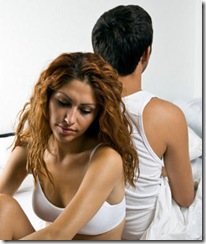 Many women experience problems in the bedroom at one time or another. Female sexual dysfunction is not uncommon and although some women and healthcare providers have difficulty discussing it, it has been recognized by the medical community for decades. In fact, for the last twenty years, it has been listed in the Diagnostic and Statistical Manual of Mental Disorders, a manual published by the American Psychiatric Association, used to classify and diagnose psychological disorders.
Many women experience problems in the bedroom at one time or another. Female sexual dysfunction is not uncommon and although some women and healthcare providers have difficulty discussing it, it has been recognized by the medical community for decades. In fact, for the last twenty years, it has been listed in the Diagnostic and Statistical Manual of Mental Disorders, a manual published by the American Psychiatric Association, used to classify and diagnose psychological disorders.
Female sexual dysfunction (FSD) can develop at any age, but many women report sexual problems at times of hormonal fluctuation; for example: post-pregnancy or during menopause. FSD encompasses several conditions that can have an effect on a woman’s health and cause concern and suffering. These symptoms include:
– The desire to have sex is low or absent.
– An inability to maintain arousal during sexual activity, or become aroused despite a desire to have sex.
– An inability to experience an orgasm.
– Pain during sexual contact.
Hypoactive sexual desire disorder (HSDD) affects roughly 1 in 10 women and is the most common sexual dysfunction among women of all ages. It is sometimes difficult to diagnose because a woman’s sex drive varies tremendously from person to person. And the factors causing a lowered sex drive can range from psychological to biological. But some women underestimate what an important role sexual health plays in their overall health and well-being. And if the lack of desire becomes distressing in any way or interferes with her overall quality of life, she may have HSDD.
Many women suffer in silence and some even feel that a decline in sexual desire is a normal part of aging. According to Sheryl A. Kingsberg, PhD, a clinical psychologist and Professor in the Department of Reproductive Biology at Case Western Reserve University School of Medicine in Cleveland, Ohio: “Women should not be expected to accept a distressing loss of sexual desire any more than they should be expected to simply accept arthritis, acid reflux, or any other condition often associated with aging.”
Unfortunately, HSDD in women is not as well recognized as erectile dysfunction (ED) in men. There are many medications available for the treatment of ED, but currently, there are no US FDA approved medications for women with HSDD. “The problem is further compounded by a lack of attention and interest in women’s sexual satisfaction in many cultures,” says Kingsberg. And as a result, “some women may feel that it is not appropriate to seek help for a sexual problem.”
There are options available. An important step in getting help for FSD is realizing that there is a problem. Too many women ignore their symptoms or are unable to recognize that they have a treatable issue. Kingsberg suggests that: “Women should speak to their partners about the problem and (they may consider) seeing a professional for guidance; this professional may be a counselor, a sex therapist, a physician or nurse practitioner, or some other trusted person.”
Psychotherapy or sex therapy can be very effective in uncovering the different components that may contribute to the problem. There are a few medical treatments which include hormonal therapies that may help some women. “A number of other very exciting new approaches to the treatment of low sexual desire in women are under development,” say Kingsberg, “and may be available soon.”
The Society for Women’s Health Research (SWHR), a national non-profit organization based in Washington D.C., is widely recognized as the thought leader in women’s health research, particularly how sex differences impact health. SWHR’s mission is to improve the health of all women through advocacy, education and research. Visit SWHR’s website at swhr.org for more information.
